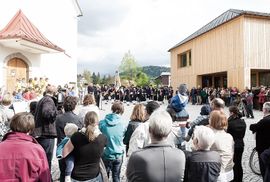Aktuelle Version vom 10. Dezember 2020, 14:18 Uhr
Information zur Nachricht (bearbeiten ) Zu dieser Nachricht ist keine Dokumentation vorhanden.
Sofern du weißt, wo und in welchem Zusammenhang sie genutzt wird, kannst du anderen Übersetzern bei ihrer Arbeit helfen, indem du eine Dokumentation hinzufügst.
Nachricht im Original (Pfarrhaus Krumbach )
{{Standort
{{Standort
|Standort= Österreich 6942 Krumbach
|Kategorie= Best practice examples
}}
{{Gallerie Element
|Bild=Pfarrhaus Krumbach.jpg
}}
{{Best practice objekte
|Bauherr=Gemeinde Krumbach
|Jahr der Fertigstellung=2015
|Baukosten € brutto=n.bek.
|Heizungsart=n.bek.
|Projektbeschreibung=Die Gemeinde Krumbach verfolgt seit über zehn Jahren ein engagiertes Bauprogramm, welches sich im Wesentlichen mit der baulichen Entwicklung des Dorfkerns befasst. Begleitet wird diese Entwicklung seit geraumer Zeit von einer Arbeitsgemeinschaft aus drei Architekturbüros, die 2008 mit einer Studie über die mittelfristige Entwicklung des Dorfkerns betraut wurde. Als Meilenstein in diesem Prozess wurde im November 2013 das Pfarrhaus fertig gestellt. In seiner Funktion als Kultur- und Mehrzweckgebäude hat das Haus neben seiner baulichen Präsenz am Dorfplatz eine wichtige Position im öffentlichen Dorfleben eingenommen. Sind doch neben dem Pfarrsaal (kleiner Dorfsaal) und der Pfarrkanzlei samt Pfarrwohnung die öffentliche Bücherei und das Probelokal für Musikverein und Chor in diesem Gebäude vereint. Dieses vielfältige Spektrum an Nutzungen sorgt für eine zusätzliche Belebung des Krumbacher Dorfkerns. Ökologisch nachhaltiges Bauen manifestiert sich in einem „Bauen der kurzen Wege“. Aufgrund des vitalen Handwerks in der Region Bregenzerwald war es möglich, dass die Mehrheit (über 3/4) der ausführenden Firmen aus einem Umkreis von weniger als 30 Kilometern stammte. Die wohlüberlegte und gesellschaftlich nachhaltig wirkende Intervention zeichnet sich vor allem dadurch aus, dass die kleine Gemeinde ihren Bürgern eine Infrastruktur schafft, die ein lebendiges Dorfleben fördert und unterstützt. In diesem Zusammenhang entspricht das Pfarrhaus Krumbach einem idealtypischen Bauwerk.
|Baustoff Holz=Weißtanne
|Planungsprozess=Bernardo Bader Architekten, Dornbirn, Architekten Hermann Kaufmann ZT GmbH, Schwarzach, Bechter Zaffignani Architekten, Bregenz
|Bauabwicklung=Fetz Holzbau GmbH, Egg, Zimmerei Gerhard Bilgeri, Riefensberg, Oberhauser & Schedler Bau GmbH, Andelsbuch
|Informationen zur Regionalität=„Bei uns in Krumbach ist es Standard, dass wir kommunale Gebäude aus regionalem Holz bauen. Dazu braucht es keine lange Diskussion. Für die Architekten ist die Holzbauweise herausfordernder, weil bis ins Detail geplant werden muss. Aber unsere erfahrenen Architekten drängten sehr darauf, ein Holzgebäude umzusetzen. Sogar der Liftschacht ist bei uns in Holzbauweise ausgeführt – das ist vom Brandschutz her möglich, wenn der Wille vorhanden ist. Nur die wenigen langen Holzkonstruktionsteile kamen von auswärts. Der überwiegende Teil des Holzes (Weißtanne) kommt aus dem Dorf. In einer Holzaktion haben wir das organisiert. Gesägt und getrocknet wurde in Hittisau und alle Handwerke bezogen das Holz von dort. Die Handwerker waren sehr motiviert mitzumachen. Es gab keine Mehrkosten, die Projektkostenschätzung wurde sogar unterschritten. Wichtig bei so einem Bauprojekt sind ein engagierter Bauleiter und frühzeitige Planung. Von der Qualität des Pfarrhauses sind heute noch alle BesucherInnen begeistert.“
}} Übersetzung {{Standort
Standort Österreich 6942 Krumbach
Koordinaten 47° 29' 14", 9° 55' 11"
Principal
Community of Krumbach
Address
Energy planning
year fo finalisation
2015
Construction costs € brutto
unkown
Base area[m²]
Useful area[m²]
Cubage [m³]
Heating demand [kWh/(m²BGFa]
Heatingsystem
unkown
Technical data other object types
Project description
For more than ten years, the municipality of Krumbach has been pursuing a committed building programme, which is essentially concerned with the structural development of the village centre. This development has been accompanied for some time by a consortium of three architectural firms, which was commissioned in 2008 with a study on the medium-term development of the village centre. As a milestone in this process, the vicarage was completed in November 2013. In its function as a cultural and multi-purpose building, the house has taken on an important position in public village life in addition to its structural presence on the village square. In addition to the parish hall (small village hall) and the parish office including the parish flat, the public library and the rehearsal room for the music club and choir are united in this building. This diverse spectrum of uses provides an additional boost to the centre of Krumbach village. Ecologically sustainable building manifests itself in a "building of short distances". Due to the vital craftsmanship in the Bregenzerwald region, it was possible that the majority (over 3/4) of the companies carrying out the work came from within a radius of less than 30 kilometres. The well-considered and socially sustainable intervention is characterised above all by the fact that the small community creates an infrastructure for its citizens that promotes and supports a lively village life. In this context, the Krumbach vicarage corresponds to an ideal-typical building.
Construction material timber
Fir
Planning
Bernardo Bader Architekten, Dornbirn, Architekten Hermann Kaufmann ZT GmbH, Schwarzach, Bechter Zaffignani Architekten, Bregenz
Construction processing
Fetz Holzbau GmbH, Egg, Carpentry Gerhard Bilgeri, Riefensberg, Oberhauser & Schedler Bau GmbH, Andelsbuch
Information on regionality
"Here in Krumbach, it is standard practice that we construct municipal buildings from regional wood. This does not require a long discussion. For the architects, timber construction is more challenging because it has to be planned down to the last detail. But our experienced architects pushed very hard to implement a wooden building. Even the lift shaft in our building is made of wood - that's possible from a fire protection point of view if the will is there. Only the few long wooden construction parts came from outside. Most of the wood (silver fir) comes from the village. We organised this in a timber campaign. The wood was sawn and dried in Hittisau and all the craftsmen got their wood from there. The craftsmen were very motivated to participate. There were no additional costs, the project cost estimate was even undercut. A committed construction manager and early planning are important for such a building project. All the visitors are still enthusiastic about the quality of the parsonage.
Further information

